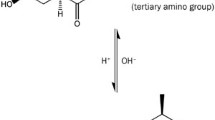Abstract
Because of the limited solubility of carbamazepine, aqueous solutions are usually prepared using glycols as cosolvents. This research focuses on the effect of varying the composition of polyethylene glycol 400 (PEG-400) in aqueous solutions on rabbit intestinal permeability of carbamazepine in the duodenojejunum and the ascending colon using an in situ perfusion technique. In both segments the intestinal permeability varied inversely with the percentage of PEG-400, when the concentration of carbamazepine in the perfusing solution was maintained constant. The decreased permeability may be explained by a reduction in the thermodynamic activity of carbamazepine with increased concentrations of PEG-400, as well as by reverse solvent drag because of the hyperosmolarity of the perfusing solutions.
Similar content being viewed by others
REFERENCES
L. Bertilsson and T. Tomson. Clinical pharmacokinetics and pharmacological effects of carbamazepine and carbamazepine-10,11-epoxide. Clin. Pharmacokinet. 11:177–198 (1986).
J. W. Faigle, S. Brechbuhler, K. F. Feldmann, and W. J. Richter. The biotransformation of carbamazepine. In W. Birkmayer (ed.), Epileptic Seizures-Behaviour-Pain, Hans Huber, Bern, 1976, pp. 127–140.
M. Sumi, N. Watari, O. Umezawa, and N. Kaneniwa. Pharmacokinetic study of carbamazepine and its epoxide metabolite in humans. J. Pharmaco-bio-Dyn. 10:652–661 (1987).
R. H. Levy, W. H. Pitlick, A. S. Troupin, J. R. Green, and J. M. Neal. Pharmacokinetics of carbamazepine in normal man. Clin. Pharmacol. Ther. 17:657–668 (1975).
R. H. Levy, J. S. Lockard, J. R. Green, P. Friel, and L. Maris. Pharmacokinetics of carbamazepine in monkeys following intravenous and oral administration. J. Pharm. Sci. 64:302–307 (1975).
M. Sumi, N. Watari, H. Naito, O. Umezawa, and N. Kaneniwa. Influence of phenobarbital on pharmacokinetics of carbamazepine and its epoxide in the rabbit. Yakugaku Zasshi 107:984–991 (1987).
P. J. Wedlund and R. H. Levy. Time-dependent kinetics. VII. Effect of diurnal oscillations on the time course of carbamazepine autoinduction in the rhesus monkey. J. Pharm. Sci. 72:905–909 (1983).
W. H. Pitlick and R. H. Levy. Time-dependent kinetics. I. Exponential autoinduction of carbamazepine in monkeys. J. Pharm. Sci. 66:647–649 (1977).
I. H. Patel and R. H. Levy. Intramuscular absorption of carbamazepine in rhesus monkeys. Epilepsia 21:103–109 (1980).
I. H. Patel, P. J. Wedlund, and R. H. Levy. Induction effect of phenobarbital on the carbamazepine to the carbamazepine-10,11-epoxide pathway in rhesus monkeys. J. Pharmacol. Exp. Ther. 217:555–558 (1981).
N. F. H. Ho and W. I. Higuchi. Theoretical model studies of intestinal drug absorption. IV. Bile acid transport at perimicellar concentrations across diffusion layer-membrane barrier. J. Pharm. Sci. 63:686–690 (1974).
N. F. H. Ho, J. Y. Park, P. F. Ni, and W. I. Higuchi. Advancing quantitative and mechanistic approaches in interfacing gastrointestinal drug absorption studies in animals and humans. In W. Crouthamel and A. C. Sarapu (eds.), Animal Models for Oral Drug Delivery in Man, APhA, Washington, D.C., 1983, pp. 27–106.
R. J. Sawchuk and W. M. Awni. Absorption of cyclosporine from rabbit small intestine in situ. J. Pharm. Sci. 75:1151–1156 (1986).
J. T. Doluisio, G. H. Tan, N. F. Billups, and L. Diamond. Drug absorption. II. Effect of fasting on intestinal drug absorption. J. Pharm. Sci. 58:1200–1202 (1969).
L. E. Riad and R. J. Sawchuk. Simultaneous determination of carbamazepine and its epoxide and transdiol metabolites in plasma by microbore liquid chromatography. Clin. Chem. 33:1863–1866 (1988).
I. Johno, K. Kawakatsu, H. Kuwata, and S. Kitazawa. Segmental differences in transmucosal fluid movement and its effect on gastrointestinal drug absorption in rabbits. Int. J. Pharm. 25:255–263 (1985).
S. Kitazawa, H. Ito, and H. Sezaki. Transmucosal fluid movement and its effect on drug absorption. Chem. Pharm. Bull. 23:1856–1865 (1975).
V. S. Chadwick, S. F. Phillips, and A. F. Hoffman. Measurement of intestinal permeability using low molecular weight polyethylene glycols (PEG 400). I. Chemical analysis and biological properties. Gastroenterology 73:241–246 (1977).
V. S. Chadwick, S. F. Phillips, and A. F. Hoffman. Measurement of intestinal permeability using low molecular weight polyethylene glycols (PEG 400). II. Application to normal and abnormal permeability states in man. Gastroenterology 73:247–251 (1977).
J. R. Pappenheimer and K. E. Zich. Absorption of hydrophilic solutes from the rat small intestine. J. Physiol. (London) 371:138P (1985).
J. R. Pappenheimer and K. Z. Reiss. Contribution of solvent drag through intercellular junctions to absorption of nutrients by the small intestine of the rat. J. Membrane Biol. 100:123–136 (1987).
N. Lifson and A. A. Hakim. Simple diffusive-convective model for intestinal absorption of a nonelectrolyte (urea). Am. J. Physiol. 211:1137–1146 (1966).
N. Lifson, L. M. Gruman, and D. G. Levitt. Diffusive-convective models for intestinal absorption of D2O. Am. J. Physiol. 215:444–454 (1968).
A. Karino, M. Hayashi, T. Horie, S. Awazu, H. Minami, and M. Hanano. Solvent drag effect in drug intestinal absorption. I. Studies on drug and D2O absorption clearances. J. Pharm. Dyn. 5:410–417 (1982).
A. Karino, M. Hayashi, S. Awazu, and M. Hanano. Solvent drag effect in drug intestinal absorption. II. Studies on drug absorption clearance and water influx. J. Pharm. Dyn. 5:670–677 (1982).
O. Kedem and A. Katchalsky. A physical interpretation of the phenomenological coefficients of membrane permeability. J. Gen. Physiol. 45:143–179 (1961).
H. Kameda, T. Abei, S. Nasrallah, and F. L. Iber. Functional and histological injury to intestinal mucosa produced by hypertonicity. Am. J. Physiol. 214:1090–1095 (1968).
A. J. Bryan, R. Kaur, G. Robinson, N. W. Thomas, and C. G. Wilson. Histological and physiological studies on the intestine of the rat exposed to solutions of Myrij 52 and PEG 2000. Int. J. Pharm. 7:145–156 (1980).
Author information
Authors and Affiliations
Rights and permissions
About this article
Cite this article
Riad, L.E., Sawchuk, R.J. Effect of Polyethylene Glycol 400 on the Intestinal Permeability of Carbamazepine in the Rabbit. Pharm Res 8, 491–497 (1991). https://doi.org/10.1023/A:1015803312233
Issue Date:
DOI: https://doi.org/10.1023/A:1015803312233




